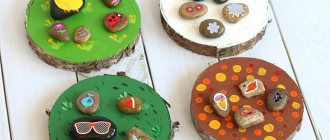Lesson summary in 1st grade on the topic “Music - the art of sounds”
Lesson summary at the Children's Art School on the topic "Music - the art of sounds"
Open lesson on the subject “Listening to Music”
Introductory conversation
Author: Koretskaya Natalya Vladimirovna, teacher at the Municipal Budgetary Educational Institution "DSHI" in the village. Vostok, Primorsky Territory Description of work: I offer you a lesson summary on the subject “Listening to Music” in the 1st grade of the Children’s Art School on the topic: “Music - the art of sounds.” This material will be useful for primary school teachers, music teachers of secondary schools, teachers of Children's art schools and music schools. Purpose: Introduction and familiarization with the academic subject “Listening to Music”. Fostering a culture of listening and perceiving music Objectives: To awaken interest in music from the first lesson of first grade students, introduce songs about music, teach to listen and hear the sounds of nature, teach the skills of analyzing musical works (songs), form a positive attitude towards music in children, develop the emotional sphere of the child, develop the creative abilities and communication skills of pupils, cultivate cohesion and mutual understanding through collective creative activities. Musical material: G. Struve. “I want to hear music”; E. Krylatov. “Where does music come from?”; Lyadov “Musical snuffbox” Equipment: Audio recordings of songs; computer, music speakers. Stages of the lesson: Organizational (preparation for the lesson, placing participants on site, preparing attributes and didactic materials for the lesson). Preparatory (introduction) Main (work on the topic of the lesson). Final (lesson conclusions, summing up, encouraging participants).
Lesson progress
Organizational stage: Teacher: Hello, guys! Our lesson will be extraordinary; you and I will plunge into the wonderful world of music and sounds. First, we need to get to know each other, don't we? My name is Natalya Vladimirovna, I am your teacher, I want to teach you to love and understand music. Creating a positive emotional background, a psychological mood for the upcoming work: a smile, the friendliness of the teacher, freeing children from constriction and fear, intensifying attention. Each child is invited to say his name. Teacher: Great! Preparatory stage: Communicating the topic and purpose of the lesson. Teacher: The topic of our lesson is “Music - the art of sounds”, you will learn to listen and hear the sounds around us and we will try to understand together - what is music?
And now I invite you to listen carefully to the silence. Are you guys hearing anything now? After a pause, the children take turns timidly raising their hands and hesitantly naming the sounds they heard: from an open window, the sounds of a car passing by, the rustle of falling leaves, the buzzing of a fly, the sound of a hammer somewhere in the distance, the voices of children in the corridor, etc. Teacher: That's right, well done, all these are sounds. There is a conversation about different sounds: pleasant, unpleasant, loud, quiet. Children remember various short stories from life about sounds.
Main stage: Teacher: Guys, I suggest you listen to a wonderful song by composer G. Struve. "I want to hear music." Let's listen carefully to what this song says.
The audio recording of the song is turned on. G. Struve. "I want to hear music." After listening, the guys clearly retell the lyrics of the song, naming the main points. Teacher: Well done, guys. You listened carefully. Tell me, did you like the song? Why did you like it?
The children liked the song, but the students still cannot answer the second question; parents present at the lesson come to the rescue, choosing the words “kind, affectionate song.” Gradually, the guys join the conversation and continue to select characterizing words. One of the guys noted that the song has beautiful music. Teacher: That's right, guys. The song, indeed, has not only good words, but also beautiful music.
Teacher: I suggest you listen to another song about music. Let's listen carefully again and answer the question that will be asked in the song. An audio recording of E. Krylatov’s song “Where does music come from?” is played. After listening, the children, without waiting for questions from the teacher, immediately raise their hands to answer. The students correctly heard the question in the song, and noted that the song also contains answers to this question.
Teacher: Yes, you heard everything correctly. The song is called “Where does music come from?”, and it was written by the wonderful composer E. Krylatov. What follows is an analysis of what was heard and the nature of the song. The children, together with their parents, select suitable characterizing words, compare them with the previous song, and note that the last song is sad. Teacher: Guys, when did you personally hear music for the first time? Children “remember themselves”, name different small ages, different circumstances. In the conversation, the teacher brings the topic of conversation to the Birth of a child, to lulling, to a mother’s lullaby. Children “remember” their mother’s (grandmother’s) songs and bedtime stories with joy and surprise. Everyone comes to the conclusion that the first music heard in every person’s life is a mother’s lullaby.
Teacher: Guys, when do you think music itself was born? There is a pause. The guys are in trouble. Presumably dates are given - a hundred years ago, a thousand years ago. Teacher: No, guys. Not a hundred, not a thousand... much, much more. No one can say exactly when and how music was born. But we can dream up with you...
By discarding various historical events, everyone comes to the conclusion that perhaps ancient people invented music. An improvisation of a scene from the lives of ancient people follows. The guys choose their own roles: “hunters” are boys, “housewives” are girls.” Everyone invented tools for labor and hunting, clubs, spears, bows, etc. Each child, sitting in his place, comes up with his own actions and is happy to tell and show to the class.
The teacher directs the general story in a certain direction: The hunters went hunting.
Nikita has a bow, Artyom has a spear, Vova has a club. Nikita pulled the bowstring and shot at the mammoth. What did Nikita hear at that moment? Children try to imitate the sound. Artyom also threw his spear at the mammoth. What did he hear? The girls went to the forest to pick berries. Sveta accidentally stepped on a stick. What did she hear? Etc. Different situations are played out with the participation of each child.
The continuation of the general “story” implies the hunters coming home, where the girls are waiting, cooking, singing and dancing around the fire, where all the heroes take part with the sounds accumulated during the day.
Teacher: So, guys, you and I composed our own version of how music was born. Who knows, maybe that’s how it was? Children and adults agree.
Teacher: Guys, do you have musical instruments at home? Which? Children call if there is one. They also remember that they have a TV, computer, and player at home where they can listen to music. Teacher: Do you know that before, when there were no televisions or computers, people came up with small boxes, boxes with a mechanism, when opened, beautiful magical music sounded. It was a pleasure to give such boxes for the holidays and to receive them as a gift. I suggest you listen to A. Lyadov’s work “The Musical Snuff Box”
An audio recording of A. Lyadov’s “Musical Snuff Box” is played. The children listen attentively. After listening, analysis and characteristics of the work. Children use the words: “Magic music, subtle, transparent, gentle, danceable.”
Final stage: Teacher: Guys, weren’t you bored, are you feeling well? Children: Yes. Teacher: What did we do in class today? – Children remember listening to sounds, songs, playing “Ancient People” Teacher: Did you like listening to music? Children: Yes. Teacher: What did we listen to today? – Children name the works, note which work they liked best and why. As homework, the children are invited to draw a picture about music, recite poems about music, or come up with their own short story about music. Teacher: Thank you for your active work, guys!!! May music always live in your hearts. Literature used: Vladimirova O. A. Work program for the discipline “Listening to Music” for children’s music schools and children’s art schools. St. Petersburg, 2006 Lysenko S. F. “Listening to music” as a subject of musical literature at the initial stage of training in children’s music schools” Methodological work. Nakhodka, 2004 Tsareva N. Lessons from Mrs. Melody. Toolkit. M., 2007
We recommend watching:
Scenario of a festival of national culture for school-age children Melody and accompaniment as a background in a musical work Development of cello playing skills in children Graduation party at a music school. Scenario
Similar articles:
Riddles about music for children
MUSIC. Lesson developments in music for 4th grade of secondary schools
Music quiz for schoolchildren of grades 9, 10, 11
Festival "Davydovsky". Results
Class hour 7, 8 class on the topic: How to protect yourself from trouble
Summary of a musical thematic lesson on listening to music “In the world of musical instruments”
Summary of a musical thematic lesson on listening to music “In the world of musical instruments”
Author: - music director of the municipal budgetary preschool educational institution "Child Development Center - Kindergarten No. 6 of Novy Oskol, Belgorod Region"
Let me present you with a summary of a lesson on listening to music in the preparatory group. This is a final lesson on the properties and characteristics of musical instruments.
Target:
enrich children's knowledge about the properties and characteristics of musical instruments; learn to distinguish their timbre coloring. To develop the ability to find common and different features of identical instruments. Introduce the definitions: “Classical, folk, pop music, symphony, folk orchestra.
Equipment:
a screen behind which there is a violin, balalaika, guitar, stereo, gramophone. recording of musical instruments.
Progress of the lesson.
Music supervisor:
Today, guys, I will introduce you to musical instruments that are similar in appearance to each other. What kind of tools these are, try to guess for yourself. They are all called strings, but they play different music; on one classical, on the other folk, on the third - pop. They can sound independently or in an orchestra: symphony, folk, pop. But they don’t play together in the same orchestra because they sound different. What tools do you think I'm talking about?
(Children's answers).
- How do we know what instrument sounds if we don’t see it?
Children:
by sound.
Music supervisor:
Now we will listen to a short excerpt in the recording, and you will answer what instrument I will talk about. (A violin sounds behind the screen. Children answer)
Music supervisor:
Of course it's a violin. No wonder she is called the queen of the orchestra for her unusual sound. (Tool display).
Music supervisor:
The violin is the main musical instrument in a symphony orchestra. People who play the violin are called violinists. There are many of them in the symphony orchestra. They say about the violin that it sings with a human voice. Therefore, she is the main one in the orchestra.
The sound recording is playing. Vivaldi Concerto for violin and orchestra.
Music supervisor:
We will see this instrument more than once again.
Game "Winter Dance".
Music supervisor:
Now let's talk about another tool. (A balalaika plays behind the screen.) Children recognize it by its sound. Look carefully at the balalaika and tell me how it is similar to a violin? (Children's answers). How is it different? (Children's answers). Right. Learning to play the balalaika is easier than learning to play the violin. Look, I don't need a bow to play. And on the fingerboard there is a special line. They are designed to accurately reproduce sounds. A musician plays the violin by ear, and this is very difficult. People loved to play the balalaika at folk festivals. People sang funny songs, ditties, and choruses. Everyone demonstrated their singing skills. You and I also know ditties.
Children perform ditties.
Music supervisor:
During the festive festivities, many folk musicians gathered. They played balalaikas, accordions, spoons, whistles, rattles, even washboards and saws. There was no end to the fun.
Sounds in the Kamarinskaya recording.
Music supervisor:
Now guess what kind of instrument we will see and hear now. (A guitar sounds behind the screen). That's right - it's a guitar (showing a guitar). Probably one of your relatives and friends plays the guitar. (Children's answers.) How is it similar to the violin and balalaika? (Children's answers). The electric guitar is the main instrument in a pop orchestra and ensemble.
A recording of a guitar sounds.
Music supervisor:
There is another stringed, or rather keyboard-stringed instrument. you hear it every time you come into the hall (piano). Musicians call it a piano. Now we will see where the strings are. (Opens the lid of the piano, showing the children hammers that strike the strings. Explain the purpose of the pedals.) The piano is considered an instrument that can replace an entire orchestra. And now I suggest you dance a little.
Dance "Ducklings".
Music supervisor:
Guys, let's remember what tools we talked about today (answers). What orchestras do they play in? Which instrument is called the queen of music? What instrument can replace an entire orchestra?



